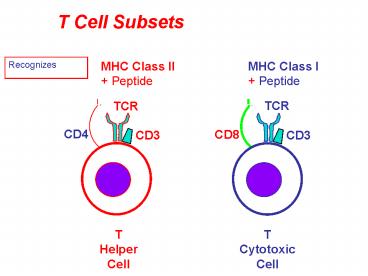T Cell Subsets - PowerPoint PPT Presentation
1 / 27
Title:
T Cell Subsets
Description:
Rickettsia sps. Bacteria. Candida. Helminths (Worms) Vesicular. Cytosolic ... Rickettsia sps. Bacteria. Candida. Helminths (Worms) CD4 T Cells. CD8 T Cells ... – PowerPoint PPT presentation
Number of Views:50
Avg rating:3.0/5.0
Title: T Cell Subsets
1
T Cell Subsets
MHC Class II MHC Class I Peptide Peptide
Recognizes
TCR
TCR
CD4
CD8
CD3
CD3
T Helper Cell
T Cytotoxic Cell
2
Antigen Processing and Presentation to T
Lymphocytes
Lecture 7
3
Immune Responses are initiated in the Peripheral
lymphoid organs
4
(No Transcript)
5
(No Transcript)
6
Dendritic Cell Migration and Antigen Presentation
7
- How do antigenic peptides end up binding to MHC?
- What determines whether Ag. Is presented by MHC I
or II? - How can you target CD4 vs. CD8 T Cells?
- Physiological Significance
8
Bacteria Candida Helminths (Worms)
Mycobacteria Salmonella Leishmania Trypanosoma His
toplasma Yersinia pestis
Viruses Listeria Chlamydia sps. Rickettsia sps.
9
Vesicular
Cytosolic
10
Exogenous/Endocytic Pathway
11
Virus
Endogenous/cytosolic Pathway
12
(No Transcript)
13
Cell Biology of Antigen Processing
14
Antigen Presentation to CD8 T Cells
15
Which cells can present antigen to CD8 T cells?
And Why?
- All nucleated cells
16
Endogenous/Cytosolic Pathway
MHC I Pathway of Processing of Cytosolic Proteins
17
(No Transcript)
18
(No Transcript)
19
Antigen Presentation to CD4 T Cells
20
Which cells can present antigen to CD4 T Cells?
And Why?Professional Antigen Presenting
Cells Dendritic Cells Macrophages B cells
21
Exogenous/Endocytic Pathway
Invariant Chain
22
(No Transcript)
23
(No Transcript)
24
Antigen Presentation by Macrophage
Macrophage
T Cell
25
Numerous T Cells Interacting with a Single
Macrophage
26
Physiologic Significance of MHC II-Associated
Antigen Presentation
27
Bacteria Candida Helminths (Worms)
Mycobacteria Salmonella Leishmania Trypanosoma His
toplasma Yersinia pestis
Viruses Listeria Chlamydia sps. Rickettsia sps.
CD4 T Cells
CD8 T Cells
CD4 T Cells































